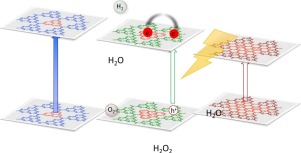Applied Catalysis B: Environment and Energy ( IF 20.2 ) Pub Date : 2018-01-17 , DOI: 10.1016/j.apcatb.2018.01.030 Dan Qu , Juan Liu , Xiang Miao , Mumei Han , Haochen Zhang , Ze Cui , Shaorui Sun , Zhenhui Kang , Hongyou Fan , Zaicheng Sun

|
Photocatalytic water splitting is considered as one of the promising ways to provide clean fuels. Extensive efforts have been made in the past to develop various inorganic and organic materials systems as photocatalysts for water splitting by using visible light. Among these photocatalysts, it was recently demonstrated that incorporation of carbon dots (CDs) into graphitic carbon nitride (g-C3N4) results in new metal-free composites (g-C3N4-C) with excellent stability and impressive performance for photocatalytic water splitting. However, fundamental questions still remain to be addressed such as how added CDs influence the photocatalytic reaction through the bandgap tunability, charge transfer route and efficiency, as well as the specific function of CDs in the photocatalytic process. Understanding the chemical and physical behaviors of added CDs for the control of g-C3N4-C architecture is a critical need for its emergence from fundamental design of more efficient photocatalysts to practical applications. In this article, we report new materials with well-controlled architecture allowing for fine-tuning band gaps for broader visible light absorption and controlled understanding of the photocatalytic process. The well-defined model materials allow us to address the fundamental question regarding chemically bonding of CDs and how the chemical bonded CDs promote charge separation and transfer for highly efficient generation of H2.
中文翻译:

探讨gC 3 N 4-碳点无金属光催化剂的水分解机理
光催化水分解被认为是提供清洁燃料的有前途的方法之一。过去,已经进行了广泛的努力来开发各种无机和有机材料体系,作为通过使用可见光将水分解的光催化剂。在这些光催化剂中,最近证明,将碳点(CDs)掺入石墨氮化碳(gC 3 N 4)中可得到新的无金属复合物(gC 3 N 4-C)具有出色的稳定性和令人印象深刻的光催化水分解性能。但是,基本问题仍然有待解决,例如添加的CD如何通过带隙可调性,电荷转移途径和效率以及CD在光催化过程中的特定功能如何影响光催化反应。了解添加的CD的化学和物理行为,以控制gC 3 N 4从更高效的光催化剂的基础设计到实际应用,-C体系结构至关重要。在本文中,我们报告了具有良好控制的体系结构的新材料,这些材料允许微调带隙,以实现更宽的可见光吸收和对光催化过程的可理解理解。定义明确的模型材料使我们能够解决有关CD的化学键以及化学键的CD如何促进电荷分离和转移以高效生成H 2的基本问题。











































 京公网安备 11010802027423号
京公网安备 11010802027423号